Naperville, Illinois, Hgh State Clinic, Hgh Injections, Hrt Doctors
Naperville, Illinois Blood Testing Facilities
 Represents a LabCorp blood testing facility
Represents a LabCorp blood testing facility Represents a Quest Diagnostics blood testing facility
Represents a Quest Diagnostics blood testing facility

Nearby Labcorp Blood Testing facilities:
- Labcorp Center Distance: 3 m, 2272 W 95Th Street Ste 100, Naperville, Will County, IL, 60564
- Labcorp Center Distance: 11 m, 725 W Fabayan Parkway Suite D, Batavia, Kane County, IL, 60510
- Labcorp Center Distance: 12 m, 522 W Chestnut Street, Hinsdale, Dupage County, IL, 60521
- Labcorp Center Distance: 15 m, 330 North Madison Ste B2, Joliet, Will County, IL, 60435
- Labcorp Center Distance: 18 m, 2025 S. Chicago Street, Joliet, Will County, IL, 60436
- Labcorp Center Distance: 21 m, 450 Dundee Ave, Elgin, Kane County, IL, 60120
- Labcorp Center Distance: 22 m, 16325 Harlem Ave Ste 110, Tinley Park, Cook County, IL, 60477
- Labcorp Center Distance: 24 m, 1710 N Randall Road Ste 240, Elgin, Kane County, IL, 60123
- Labcorp Center Distance: 29 m, 2601 Compass Rd Suite 135, Glenview Nas, Cook County, IL, 60026
- Labcorp Center Distance: 33 m, 5911 Northwest Highway Ste 108, Crystal Lake, McHenry County, IL, 60014
- Labcorp Center Distance: 44 m, 35 Tower Ct Ste E, Gurnee, Lake County, IL, 60031
- Labcorp Center Distance: 47 m, 387 East 84Th Dr, Merrillville, Lake County, IN, 46410
- Labcorp Center Distance: 53 m, 9150 E 109Th Ave Ste C-1, Crown Point, Lake County, IN, 46307
- Labcorp Center Distance: 59 m, 6530 Sheridan Road, Kenosha, Kenosha County, WI, 53143
- Labcorp Center Distance: 62 m, 880 Eastport Centre 2Nd Floor, Valparaiso, Porter County, IN, 46383
- Labcorp Center Distance: 83 m, 4931 S 27Th St, Milwaukee, Milwaukee County, WI, 53221
- Labcorp Center Distance: 85 m, 12555 W National Ave, New Berlin, Waukesha County, WI, 53151
- Labcorp Center Distance: 87 m, 5631 W Lincoln Ave, West Allis, Milwaukee County, WI, 53219
- Labcorp Center Distance: 88 m, 1502 S. Layton Blvd, Milwaukee, Milwaukee County, WI, 53215
- Labcorp Center Distance: 89 m, 756 N 35Th St, Milwaukee, Milwaukee County, WI, 53223
- Labcorp Center Distance: 91 m, 3040 N 117Th St 210, Wauwatosa, Milwaukee County, WI, 53226
- Labcorp Center Distance: 92 m, 8500 W Capitol Suite 201B, Milwaukee, Milwaukee County, WI, 53222
- Labcorp Center Distance: 93 m, 5434 W Capitol Dr, Milwaukee, Milwaukee County, WI, 53216
- Labcorp Center Distance: 95 m, 1703 Clearwater Ave, Bloomington, McLean County, IL, 61704
Nearby Quest Blood Testing facilities:
- Quest Center Distance: 1 m, 640 S Washington St, Naperville, Dupage County, IL, 60540-6693
- Quest Center Distance: 5 m, 484 W Boughton Rd, Bolingbrook, Will County, IL, 60440-2398
- Quest Center Distance: 6 m, 7530 Woodward Ave, Woodridge, Dupage County, IL, 60517-3100
- Quest Center Distance: 7 m, 24600 W 127Th St, Plainfield, Will County, IL, 60585-9507
- Quest Center Distance: 9 m, 1113 Fairview Ave, Westmont, Dupage County, IL, 60559-2709
- Quest Center Distance: 10 m, 1180 W Wilson St, Batavia, Kane County, IL, 60510-7693
- Quest Center Distance: 12 m, 534 Chestnut St, Hinsdale, Dupage County, IL, 60521-3175
- Quest Center Distance: 13 m, 2631 Williamsburg Ave, Geneva, Kane County, IL, 60134-1111
- Quest Center Distance: 15 m, 310 N Hammes Ave, Joliet, Will County, IL, 60435-5676
- Quest Center Distance: 16 m, 1100 W Veterans Pkwy, Yorkville, Kendall County, IL, 60560-4728
- Quest Center Distance: 19 m, 885 S Randall Rd, Elgin, Kane County, IL, 60123-3002
- Quest Center Distance: 20 m, 610 S Maple Ave, Oak Park, Cook County, IL, 60304-1091
- Quest Center Distance: 21 m, 19070 Everett Blvd, Mokena, Will County, IL, 60448-2073
- Quest Center Distance: 22 m, 10837 S Cicero Ave, Oak Lawn, Cook County, IL, 60453-6458
- Quest Center Distance: 23 m, 1100 W Central Rd, Arlington Heights, Cook County, IL, 60005-2402
- Quest Center Distance: 25 m, 1600 Dempster St, Park Ridge, Cook County, IL, 60068-1172
- Quest Center Distance: 26 m, 337 W Northwest Hwy, Palatine, Cook County, IL, 60067-2414
- Quest Center Distance: 27 m, 4801 W Peterson Ave, Chicago, Cook County, IL, 60646-5725
- Quest Center Distance: 28 m, 19150 South Kedzie Ave, Flossmoor, Cook County, IL, 60422-0001
- Quest Center Distance: 29 m, 2551 Compass Rd, Glenview, Cook County, IL, 60026-8042
- Quest Center Distance: 30 m, 22285 Pepper Rd, Barrington, Lake County, IL, 60010-2538
- Quest Center Distance: 31 m, 1450 Busch Pkwy, Buffalo Grove, Lake County, IL, 60089-4541
- Quest Center Distance: 32 m, 3244 Sycamore Rd, Dekalb, Dekalb County, IL, 60115-4941
- Quest Center Distance: 33 m, 17665 Torrence Ave, Lansing, Cook County, IL, 60438-4839
- Quest Center Distance: 34 m, 260 E Congress Pkwy, Crystal Lake, McHenry County, IL, 60014-6235
- Quest Center Distance: 35 m, 565 Lakeview Pkwy, Vernon Hills, Lake County, IL, 60061-1839
- Quest Center Distance: 36 m, 8840 Calumet Ave, Munster, Lake County, IN, 46321-2546
- Quest Center Distance: 42 m, 175 E Bethel Dr, Bourbonnais, Kankakee County, IL, 60914-1456
- Quest Center Distance: 44 m, 15 Tower Ct, Gurnee, Lake County, IL, 60031-5708
- Quest Center Distance: 46 m, 1854 E Grand Ave, Lindenhurst, Lake County, IL, 60046-7821
- Quest Center Distance: 47 m, 119 E 93Rd Ave, Crown Point, Lake County, IN, 46307-8601
- Quest Center Distance: 54 m, 641 Highgrove Pl, Rockford, Winnebago County, IL, 61108-2506
- Quest Center Distance: 57 m, 10117 74Th St, Kenosha, Kenosha County, WI, 53142-7533
- Quest Center Distance: 58 m, 5901 E Riverside Blvd, Rockford, Winnebago County, IL, 61114-4935
- Quest Center Distance: 59 m, 813 N. Porter Campus Dr, Valparaiso, Porter County, IN, 46383-8947
- Quest Center Distance: 84 m, 4852 S 6Th St, Milwaukee, Milwaukee County, WI, 53221-2462
- Quest Center Distance: 89 m, 2500 Niles Rd, Saint Joseph, Berrien County, MI, 49085-3272
- Quest Center Distance: 91 m, 2600 N Mayfair Rd, Wauwatosa, Milwaukee County, WI, 53226-1309
- Quest Center Distance: 96 m, 503 N Prospect Rd, Bloomington, McLean County, IL, 61704-7723
Hormone Replacement Therapy Services for the State of Illinois
Are you over the age of thirty and feel that symptoms related to premature aging are bringing you down? You may actually be suffering from a condition known as hormone imbalance. Two of the most common forms of Hormone Imbalance which are associated with the aging process are Testosterone Deficiency and Human Growth Hormone Deficiency.
The Conscious Evolution Institute provides Pharmaceutical Hormone Replacement Therapy Solutions for men and women all across the United States.
HGH Deficiency Treatments in Chicago and Greater Illinois
Do you find yourself dragging as you grow older? Are you experiencing weight gain and loss of muscle mass even though you haven't changed your lifestyle? Are you experiencing psychological issues, not associated with your life circumstances, such as depression or a loss of well-being?
You may be suffering from Human Growth Hormone Deficiency, also known as Somatopause. Human beings are sensitive to hormonal changes, and as we get older, our brains secrete less and less of this vital hormone. With regular Bio-Identical HGH Shots, it is possible to negate the effects of Somatopause, potentially improving your physiological health, improving your outlook as well as reducing your mortality risk.
Sermorelin Acetate HGH Deficiency Treatment
HGH Injections aren't the only way to restore Growth Hormone Levels, however. The Conscious Evolution Institute also offers Recombinant Sermorelin Therapy, which boosts natural HGH Production by safely stimulating the pituitary gland. We can help you decide which form of treatment is best for you.
Low-T Treatments in Chicago and Greater Illinois
Testosterone Deficiency is also a major medical disorder which has the capacity to significantly disrupt the lives of both men and women. Like HGH, Testosterone production starts to fade around the time that we reach our mid-twenties. Many men don't experience issues for years or decades, but other men are much more sensitive to these hormonal changes.
Low-T is also referred to as Andropause, because it has a tendency to become symptomatic around the same period as Menopause, and can have the same powerful impact on health and wellness. If you are experiencing severe fatigue, loss of muscle mass, anxiety, or weight gain in combination with a lack of libido or loss of sexual ability, there is a major chance that you are suffering from Low-T and can benefit from the various Bio-Identical Low-T solutions that we provide.
HCG Weight Management Treatments in Chicago and Greater Illinois
Not all hormone treatments are intended specifically to correct hormone imbalance. HCG Injections are a form of Bio-Identical Hormone Replacement Therapy which has been proven as an effective medical treatment for obesity.
For men and women that have spent years struggling with their weight, HCG has the ability to break the cycle of dieting and binging which causes so many diets to fail. HCG, when combined with low calorie diet, leads to rapid weight loss, while significantly reducing the feelings of hunger and loss of energy associated with such a diet. HCG helps break free energy trapped in your adipose fat tissue, helping you maintain a healthy metabolism even with a significant reduction in caloric consumption.
Largest Cities in Illinois
Chicago
Chicago, is the largest city in Illinois, and is one of the largest cities in the United States. The only cities in America larger than Chicago are Los Angeles and New York City. Chicago is frequently referred to by its nickname: The Windy City. It's location adjacent to Lake Michigan causes it to experience high levels of snow and wind.
Chicago is also referred to as the Second City, because of its significant size and cultural importance, historically only considered second to New York City. Because Chicago is such a large city, it has a number of sports teams. Chicago is home to the MLB teams the Chicago Cubs and White Sox. It is also home to the NFL Chicago Bears and the NBA Chicago Bulls.
Aurora
Aurora is the second largest city in Illinois, as well as the largest suburb of Chicago. Historically, Aurora was known as The City of Lights, because it was among the first places in America to have street lights controlled completely by electricity.
A unique thing about Aurora is that it has a high concentration of buildings with renowned architecture, with buildings designed by architectural mavens such as Bruce Goff and Frank Lloyd Wright. Like many cities in the Midwest, Aurora has long been known for its significant contribution to national manufacturing.
Rockford
Rockford, Illinois is the third largest city in the state of Illinois, and the largest city outside of the Metro Chicago area. Rockford is often mentioned by the nickname, The Forest City, because of the many large elm trees located throughout the city. It was also one of the first cities in the United States with organized baseball, hosting a team called the Rockford Forest City.
Rockford has experienced issues in recent years because of the decline of the manufacturing sector in the Midwest, but has entered a new era of revitalization in recent years. Today, the largest private sector business in the city is Belvedere Assembly Plant for Chrysler and the largest Public Sector employer is the Rockford school system.
Joliet
Joliet, Illinois is the fourth largest city in Illinois, and is the second largest suburb of Chicago. Joliet is located southwest of Chicago, and is growing faster than any other city in the state. Joliet is often referred to as The City of Champions because of the massive success of the bands of the Joliet Township public school system.
Joliet, like many other cities in the Rust Belt, experienced a significant loss of jobs as manufacturing declined in the area, but its proximity to Chicago has caused it to bounce back in a big way as a suburb for men and women that commute to Chicago. Joliet also has an active entertainment district in its city center, with the minor league team the Joliet Slammers and Harrah's Joliet Casino.
Naperville
Naperville, Illinois is the 5th largest city in the state of Illinois, as well as the third largest suburb of Chicago. Naperville also has the unique distinction of being considered the richest city in the Midwest as well as one of the best cities to live in and raise a family in America.
Naperville belongs to an area known as the Illinois Tech and Research Corridor, and has a large number of high tech jobs, the most significant of which being Alcatel-Lucent and Nicor. Although high tech is the largest industry in the city, the largest single employer is Edward Hospital.
All About Naperville, Illinois Geographic Area
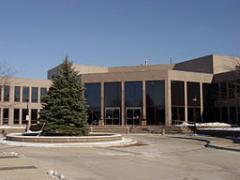

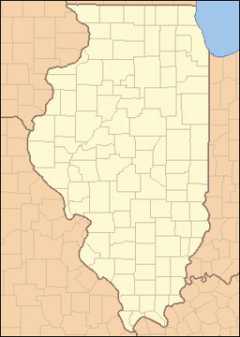
Naperville is a city in DuPage and Will counties in the U.S. state of Illinois; it was voted the second-best place to live in the United States by Money magazine in 2006. As of the 2010 census, the city had a total population of 141,857. It is the fifth-largest city in the state, behind Chicago, neighboring Aurora, Rockford, and Joliet. Approximately 100,000 Napervillians live in DuPage County, while about 45,000 reside in Will County. Once a quaint farming town, Naperville has evolved into an affluent city with numerous corporate headquarters located there. In a 2010 study, Naperville was named the wealthiest city in the Midwest and eleventh in the nation with a population over 75,000.
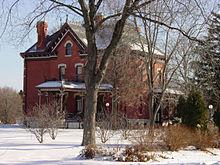
In July 1831, Joseph Naper arrived at the west bank of the DuPage River with his family and friends to found what would be known as Naper's Settlement. Among those original settlers were Naper's wife Almeda Landon, his brother John with wife Betsy Goff, his sister Amy with husband John Murray, and his mother Sarah. Their arrival followed a nearly two-month voyage across three Great Lakes in the Naper brothers' schooner, the Telegraph. Also on that journey were several families who remained in the still raw settlement that would become Chicago, including that of Dexter Graves who is memorialized in Graceland Cemetery by the well-known Lorado Taft statue "Eternal Silence" (also known as "the Dexter Graves Monument").
By 1832, over one hundred settlers had arrived at Naper's Settlement. Following the news of the Indian Creek massacre during the Black Hawk War, these settlers were temporarily displaced to Fort Dearborn for protection from an anticipated attack by the Sauk tribe. Fort Payne was built at Naper's Settlement, the settlers returned and the attack never materialized. The Pre-Emption House was constructed in 1834, as the Settlement became a stage-coach stop on the road from Chicago to Galena. Reconstructions of Fort Payne and the Pre-Emption House stand as part of Naper Settlement outdoor museum village, which was first established by the Naperville Heritage Society and the Naperville Park District in 1969 to preserve some of the community's oldest buildings.
After DuPage County was split from Cook County in 1839, Naper's Settlement became the DuPage county seat, a distinction it held until 1868. Naper's Settlement was incorporated as the Village of Naperville in 1857, at which time it had a population of 2,000. Reincorporation as a city occurred in 1890.
A predominantly rural community for most of its existence, Naperville experienced a population explosion starting in the 1960s, but largely during the 1980s and 1990s, following the construction of the East-West Tollway (now known as the Ronald Reagan Memorial Tollway) and Interstate 355 (originally known as the North-South Tollway, now the Veterans Memorial Tollway). In the past two decades, it has nearly quadrupled in size as Chicagoland's urban sprawl brought corporations, jobs, and wealth to the area.
On April 26, 1946, Naperville was the site of one of the worst train disasters in Chicagoland history. Two Chicago, Burlington and Quincy Railroad trains, the Advance Flyer and the Exposition Flyer, collided 'head to tail' on a single track just west of the Loomis Street grade crossing. The accident killed 45 and injured more than 1000 residents. This event is commemorated in a metal inlay map of Naperville on the southeast corner of the Nichols Library's sidewalk area.
The March 2006 issue of Chicago magazine cites a mid-1970s decision to make and keep all parking in downtown Naperville free, in order to keep downtown Naperville "alive" in the face of competition with Fox Valley Mall in Aurora and the subsequent sprawl of strip shopping malls. Existing parking meters were taken down, parking in garages built in the 1980s and 1990s is free, and parking is still available on major thoroughfares during non-peak hours.
Naperville marked the 175th anniversary of its 1831 founding in 2006. The anniversary events included a series of celebrations, concerts and a balloon parade.
Naperville is located at 41 °44 a²53 a³N 88 °9 a²56 a³W / 41.74806 °N 88.16556 °W / 41.74806; -88.16556 (41.7481889, na88.1656320) at an elevation of 702 ft (214 m).
According to the 2010 census, the city has a total area of 39.32 square miles (101.8 km2), of which 38.77 square miles (100.4 km2) (or 98.60%) is land and 0.55 square miles (1.4 km2) (or 1.40%) is water. Portions of the city of Naperville drain to the West Branch of the DuPage River within DuPage County. Specifically, in the flood of 1996, downtown businesses in the City of Naperville incurred a significant amount of damage. Overall, however, Forest Preserve District ownership of a large amount of property along the West Branch has minimized development in flood plains and has helped reduce the amount of damages resulting from overbank flooding that have occurred in more developed watersheds in the County.
Naperville borders the communities of Warrenville, Wheaton, Lisle, Woodridge, Bolingbrook, Plainfield, and Aurora.
According to the 2005 ae2009 American Community Survey, there were 141,644 people, 47,463 households, and 36,289 families residing in the city. As of July 1, 2009, Naperville was the 169th most populous city in the United States.
According to the 2005 American Community Survery, the population density was 4,162.8 inhabitants per square mile (1,606.3/km ²). There were 51,636 housing units at an average density of 561.3/km ² (1454.5/mi ²). The racial makeup of the city was 82.00% White, 2.54% African American, 0.07% Native American, 12.65% Asian, 0.00% Pacific Islander, 1.26% from other races, and 1.48% from two or more races. Hispanic or Latino of any race were 4.23% of the population.
There were 48,655 households out of which 45.3% had children under the age of 18 living with them, 70.0% were married couples living together, 6.2% had a female householder with no husband present, and 23.7% were non-families. 17.8% of all households were made up of individuals and 3.9% had someone living alone who was 65 years of age or older. The average household size was 3.04 and the average family size was 3.55.
In the city, the population was spread out with 30.2% under the age of 18, 7.6% from 18 to 24, 29.4% from 25 to 44, 26.7% from 45 to 64, and 6.1% who were 65 years of age or older. The median age was 35.9 years. For every 100 females there were 95.9 males. For every 100 females age 18 and over, there were 95.2 males.
The median income for a household in the city was $101,894, and the median income for a family was $130,164. Males had a median income of $82,515 versus $46,533 for females. The per capita income for the city was $48,239. About 2.5% of the population was below the poverty line, including 1.2% of those under age 18 and 9.1% of those age 65 or over.
Naperville is located within the Illinois Technology and Research Corridor. Employers contributing to the population explosion of the 1980s and 1990s included: Bell Labs and Western Electric (now Alcatel-Lucent), Amoco Research Laboratories, Nalco, Nicor, and Edward Hospital. Tellabs has its corporate headquarters in Naperville, and ConAgra's Grocery division branch office employs approximately 400 workers. OfficeMax moved its corporate headquarters there in 2006. Kraft Foods opened their Naperville site in 1968, and employs over 200 individuals at the plant, which supplies all Triscuit products for North America. Naperville is also home to the headquarters of Dukane Precast, and their double-wall precast concrete manufacturing plant. Fermilab and Argonne National Laboratory are also located nearby. Naperville was one of the ten fastest growing communities in the United States during the 1990s.
The Naperville area is home to many popular retailers, restaurants and shopping centers, such as downtown Naperville, Freedom Commons, Springbrook Prairie Pavilion, and the Route 59 and Ogden Avenue corridors. Naperville has over eleven automobile dealerships, and in October 2006, the city opened the country's first public-private automobile test track, situated on a 9-acre (3.6 ha) course, at a cost of $1.5 million.
According to the City's 2010 Comprehensive Annual Financial Report, the top ten employers in the city are:
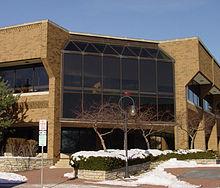
The Naperville Public Library has been ranked number one in the United States each year from 1999 through 2010, for cities with populations between 100,000 and 249,999 by Hennen's American Public Library Ratings.
There are three public library locations within the city limits:
In May 2005, a local technology company was contracted to install fingerprint scanners as a more convenient access method to the libraries internet computers, provoking some controversy. After further testing, the technology was not implemented.
The three libraries are used heavily by the public, including around one and a half million visitors and a circulation of about five million items yearly.
Naperville is home of the Naperville Independent Film Festival, an annual film festival which features the work of independent filmmakers.
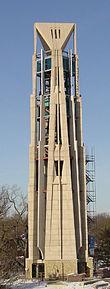
The Naperville Historic District is a set of 613 buildings, located in the older eastern section of Naperville and is listed on the National Register of Historic Places.
In 1999, Naperville was designated a White House Millennium Community, due to the construction of the Moser Tower and Millennium Carillon. The tower is a bell tower just north of Aurora Avenue and at the base of Rotary Hill within the Riverwalk Park complex. The Carillon is specially designated as a Grand Carillon, with 72 bells, and is one of only four worldwide that span six octaves. It was dedicated in an Independence Day event on June 29, 2000, with a reception attended by over 15,000, and a performance by the Naperville Municipal Band and the Naperville Men's Glee Club and Festival Chorus. The Carillon is both manually and also computer-playable, with most performances being done by hand, but with half the bells played by a computer-controlled system at set times during the day. At present, the Carillon is operational and tours are available after concerts. Disputes over funding the completion of the tower were debated before the Naperville City Council during the fall of 2005 (and are still not resolved).[dated info] The design of the tower won an award for "Best Custom Solution" from the Precast/Prestressed Concrete Institute (PCI).
Naperville is located in six townships in two counties. In Dupage County, the Northwest portion is in Winfield Township, the Northeast portion is in Milton Township, the West central portion is in Naperville Township, and the East central portion is in Lisle Township. In Will County, the Southwest portion is in Wheatland Township, and the Southeast portion is in DuPage Township. The largest number of Naperville residents live in Lisle Township, followed by Naperville Township.
Two K-12 public school districts serve the city of Naperville (along with a number of private, parochial schools, including private schools in neighboring Aurora and Lisle). Within the state of Illinois, school districts are numbered by their county.
Naperville Community Unit School District 203, established in 1972 through the merger of elementary and high school districts, serves central Naperville (as well as portions of neighboring Lisle and Bolingbrook). The current District 203 school buildings were constructed between 1928 (Ellsworth) and 2010 (Ann Reid Early Childhood Center).

The district has two high schools: Naperville Central High School and Naperville North High School, five junior high schools: Jefferson Junior High School, Kennedy Junior High School, Lincoln Junior High School, Madison Junior High School and Washington Junior High School; it has thirteen elementary schools within Naperville city limits. Additionally, the school district has one junior high and one elementary school located in Lisle.
Indian Prairie School District 204 (IPSD) was also formed through merged districts in 1972. Neuqua Valley High School, along with five middle schools and 14 elementary schools from this district, are within Naperville city limits. In total, IPSD runs and maintains 3 high schools, 7 junior high schools, 21 elementary schools, 1 preschool, and 1 alternative high school. The district serves western and southwestern Naperville, along with eastern Aurora and parts of Bolingbrook and Plainfield.
Private schools located in the city limits include St. Raphael Catholic School, SS. Peter and Paul Catholic School, All Saints Catholic Academy, Naperville Christian Classical Academy, Calvary Christian School, Bethany Lutheran School, and Chesterbrook Academy.
Naperville is the setting for a Biography Channel reality television show called Female Forces which follows female officers from the Naperville Police Department.
Naperville is also the focal city of the novel The Naperville White House: How One Man's Fantasy Changed Government's Reality (Bancroft Press, 2010). In the novel, a "fantasy government" from Naperville, Illinois becomes involved in a real-life terrorist crisis.
Edward Hospital serves Naperville while Good Samaritan in Downers Grove, Central DuPage in Winfield and two other hospitals in nearby Aurora also serve the city. For many years, Edward Hospital and others have tried to introduce a new hospital into Naperville only to have their request turned down. Thus, Naperville remains the only large Illinois city with only one hospital. Edward Hospital currently is trying to open a hospital in nearby Plainfield to help Naperville citizens with travel times to Edward Hospital.
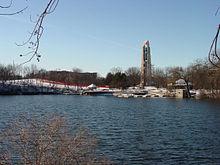
The Naperville Park District manages and provides leisure and recreational activities for Naperville and nearby residents. The District was established by referendum in 1966. As of 2007, the Park District manages over 2,400 acres (10 km2) of open space, including over 130 parks and four sports complexes. The Park District also manages two golf courses, Springbrook and Naperbrook. In addition, the Park District is responsible for the Naperville Riverwalk, construction of which began in 1981, marking the 150th anniversary of the first Joseph Naper's settlement. Some of the other facilities managed by the Park District include:
As a typical American suburb, Naperville' uses automobiles as its main mode of transportation. The Ronald Reagan Memorial Tollway (the tolled portion of Interstate 88) runs near the north edge of Naperville with 3 exits serving the city at IL 59, Winfield Rd. (in Warrenville), and Naperville Rd. Interstate 55 runs about 5 miles south of the city, through Bolingbrook and Romeoville. People wishing to reach Naperville from I-55 exit at Weber Road and head north.
US Route 34 Ogden Avenue enters Naperville in the west at Illinois Route 59 coming from Oswego and Aurora at an east-northeast/west-southwest angle. At Rickert Drive, US 34 Ogden Ave curves to the north and goes under the BNSF Railroad bridge before turning east at North Aurora Road/Raymond Dr. US 34 Ogden Ave exits the east side of the city at Naper Blvd and continues into Lisle and Downers Grove.
Illinois Route 59 travels north and south coming into town from Plainfield on the south (just south of 111th Street) and Warrenville on the north (at I-88). Route 59 is also the west border with Aurora from US 34 Ogden Ave to the BNSF Railroad bridge.
Main east-west streets include: 111th St. (Hassert Blvd.), 95th St. (Knoch Knolls Rd.), 87th St., Aurora Ave., North Aurora Rd., Diehl Rd., Rickert Dr., Royce Rd., Bailey Rd., Hobson Rd., and Chicago Ave.
Main north-south streets include: Raymond Dr., Book Rd., River Rd., West St., Naperville-Plainfield Rd., Modaff Rd., Washington St., Naper Blvd.(Naperville Rd.), and Wehrli Rd.
From 75th Street south Naperville numbered east-west streets roughly follow the same grid layout as the City of Chicago. In other words, if 75th Street continued east past its terminus at Illinois Route 83, in Willowbrook, it would eventually be the same 75th Street as found in Chicago city limits. However, the older part of Naperville has a second numerical grid, starting downtown at Main and Benton, with 4th and 5th Avenues just north of the BNSF tracks, and continuing through 15th Avenue. The difference is that the numbers in the older system go up from downtown, traveling south to north, and the other grid's numbers go up as you travel north to south. There is also a geographical based naming system, with West Street and North Street defining the older boundaries of the city. Along with these are streets named after the city they lead to, i.e., Naper/Plainfield Road heads towards Plainfield, while Aurora Avenue leads to Aurora and Chicago Avenue to Chicago (it becomes Maple Ave. in neighboring Lisle before becoming 55th Street in Downers Grove).
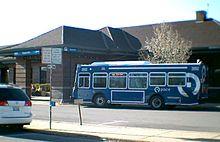
The first rail link to Chicago dates to 1864. Naperville currently has three tracks belonging to the BNSF Railway that run through the north end of town, with passenger rail service provided by Metra and Amtrak. Amtrak's three routes through Naperville are the Illinois Zephyr, the California Zephyr and the Southwest Chief. A third Metra station is planned on the STAR Line at Wolf's Crossing.
Pace provides feeder bus service to the Metra stations and local midday service, both operated under contract. It also operates bus routes from Naperville to Aurora (which serves Aurora's Westfield Fox Valley Mall) and Wheaton (which serves the College of DuPage).
There is also one private airport, the Naper Aero Club field, designation LL-10, on the western edge of town. The field is notable for being the home of the Lima Lima Flight Team.
 Nitra, Slovakia and
Nitra, Slovakia and  PR¡tzcuaro, Mexico are Naperville's official sister cities. The partnership with Nitra became official on November 17, 1993, and the partnership with PR¡tzcuaro became official on November 13, 2010.
PR¡tzcuaro, Mexico are Naperville's official sister cities. The partnership with Nitra became official on November 17, 1993, and the partnership with PR¡tzcuaro became official on November 13, 2010.
Nitra was chosen, in part, due to a desire to create a special bond with a city in one of the newly formed democracies brought about by the fall of the Iron Curtain. Nitra was also chosen due to several similarities between the two cities, such as:
Since the inception of this partnership, the Naperville Sister Cities Commission has worked to strengthen the bond between Naperville and Nitra through its support of various events and delegations. The primary goal of such sister city programs is to increase awareness of other cultures and promote international friendship, and the Naperville-Nitra partnership has so far been a successful one.
In 2002, the Sister Cities Commission supported a youth baseball exchange, sending the Naperville Patriots baseball team, composed of 15 high school age ballplayers representing each of the four high schools, Naperville Central, Naperville North, Neuqua Valley, Waubonsie Valley, in the Naperville area, to Nitra. The team travelled throughout Slovakia, and played with and held clinics for the newly formed Nitra "Little Giants" baseball team. Head coach Dave Perillo and captains Jason Fitterer and Rob Losik were responsible for organizing the clinic for the Nitra players, which proved to be a success. The Naperville Patriots also enjoyed the distinction of being the first baseball team from the United States ever to travel to the nation of Slovakia.
In addition to this exchange, the City of Naperville has supported several other events to strengthen the bond with Nitra, including:
The community at large has enthusiastically supported the Naperville-Nitra partnership, as well. In 1999, Naperville's Our Saviour's Lutheran Church raised $275,000 to rebuild a church in Nitra, which was then dedicated the following year. Our Saviour's has continuously supported churches and schools in both Nitra and Martin Slovakia, sending money, work crews, missionaries etc. NALCO and school districts 203 and 204 have also shipped 6,000 pounds of books to Nitra since 1993.
Word Count: 4147






